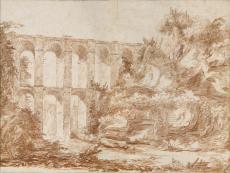


Though adjacent lots in the 1967 auction, these two drawings differ in their previous provenance. Nonetheless, they must have been produced within a relatively short time of one another – during the period of Hubert Robert’s sojourn in Rome (November 1754 – July 1765). The drawings that Robert did in the first part of his stay are more easily recognisable; a number of them are dated, and others can be compared with those made by his frequent companion, Jean-Honoré Fragonard (1732-1806), who was there from December 1756until April 1761. Some of the drawings that Robert did after his departure are also dated, but by then his mature style had formed, and it is not always easy to distinguish between those that were done at the time on the spot, and those that he did after his return to France, drawing on the great stock of images that he had accumulated in Rome. Each of the present drawings shows a site outside Rome, in Lazio. One shows a site also visited and drawn by Fragonard; the other does not. The first has traditionally been called Houses above the Cascade at Tivoli, but none of the hundreds of views made of that celebrated feature by innumerable artists over the centuries show any such buildings, or a waterfall of such a form.
What are in fact shown are those on one side of the river gulch at Ronciglione. Fragonard had stopped here on his way back to France in 1761 and made a black chalk drawing of it, dated, in the Abbé de Saint-Non’s hand, 14 April. He then went over an offset of this with bistre wash to make a collectable drawing in its own right. Ronciglione was actually reached on the day that Fragonard and Saint-Non left Rome at mid-day, on 14 April, and it is where they spent the night. Given that it was five posts (54 km) from Rome, they would be unlikely to have reached it before nightfall, so the original drawing was probably actually made the next day. It seems very possible that they were accompanied on this first stage of their journey by Robert. He made a well-known red chalk drawing of Ronciglione that is one of the great collection of his drawings given to the city of Valence by Julien-Victor Veyrenc (1756-1837) in 1835, from which he also made an oil painting. The present drawing is done from a different angle, and higher up, so that it shows the waterfall between the two cliffs that is such a distinctive feature of Ronciglione.
Civita Castellana is further north, on the road to Viterbo. Saint-Non and Fragonard did not include it in their itinerary: did Robert part with them, and go on there by himself? Or did he visit it on some subsequent occasion? Probably the latter, since a sketch of the viaduct, drawn nearer to it, so that fewer arches are shown, and with little men on the top level, is one of those in the sketchbook of 1764-1765 from the Béhague Collection that was broken up at auction.6 Drawings later in the sketchbook were of Caprarola and Cori (one of the latter dated 1765), both likewise north of Rome. The present drawing (see p. 131) served its purpose, however, as there are a number of later paintings that show a similar – but not identical – two-tier aqueduct in the distance (for example, a dramatic Mountainous Landscape with Waterfalls, and the Artist and his Wife, painted for Négrepelisse, the château of the patron of Fragonard’s second Italian journey, Bergeret de Grancourt, in 1779).
The viaduct at Civita Castellana was built over a 40-metre-deep gorge at the behest of Pope Clement XI in 1707.
A French painter, he studied with the sculptor Michel-Ange Slodtz. The drawings he made during his stay in Rome (1754-1765) supplied him with subject matter to work up into oil paintings throughout his career: Roman ruins in idealised surroundings. He returned to Paris in 1765 and enjoyed great success, not only as an artist but also as a designer of picturesque gardens, at Versailles and elsewhere. He was also involved with the development of the Louvre as a public museum.